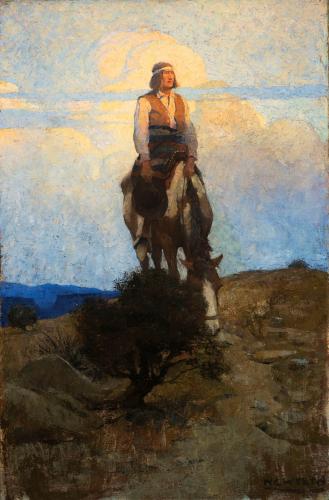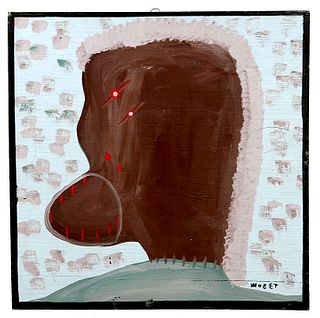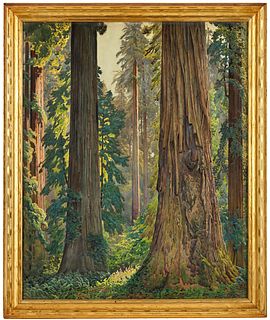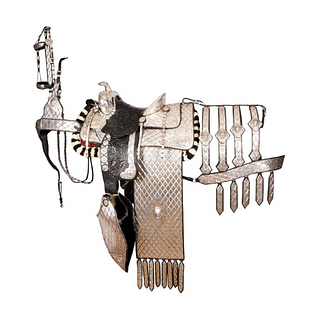Wyeth and the West Appeal
Newell Convers Wyeth, better known as N.C. Wyeth, grew up on a farm in Massachusetts at the end of the nineteenth century. Wyeth showed his artistic talent early, and studied at the Massachusetts Normal Art School in Boston. In 1902, Wyeth received the opportunity that would shape the rest of his career and firmly cement his place in the canon of American art—to study with the father of American illustration, Howard Pyle. Arguably the most successful of Pyle’s protégés, Wyeth encapsulated all of his teachings and within two years was well on his way to establishing his own career.
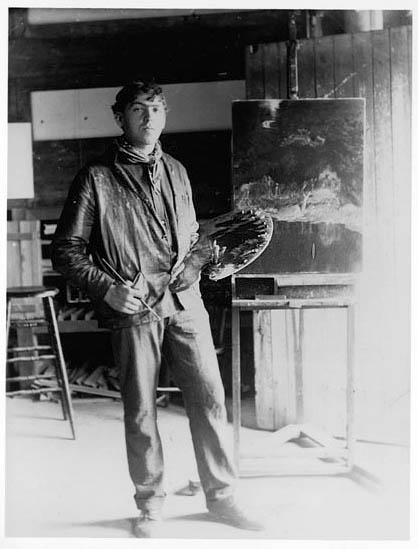
Wyeth in his studio, c. 1903, Photo Source: N.C. Wyeth Wikipedia
Wyeth ventured west in 1904 and 1906, spending vital time observing, studying, and absorbing all the rich subject matter of the west. In his own words, Wyeth described this early attraction, saying, “The West appealed to me as it would to a boy; a sort of external effervescence of spirit seemed to be all that substantiated my work.” (1) With trips to both Arizona and Colorado, Wyeth not only worked as a cowboy but also lived with the Navajo for a short time. He received numerous commissions for western subjects from Scribner’s, The Saturday Evening Post, and many more. It was during this period that Wyeth created most of his Native American pieces, including He Rode Away Following a Dim Trail Among the Sage.
A Sample of The Saturday Evening Post Cover Illustrations by N.C. Wyeth, View more here.
One of three illustrations that Wyeth created for the October 1909 issue of Red Book Magazine, this piece served to depict the moment of catharsis within the story. Detailing the struggles of Svenson, a young Navajo man, the narrative begins with his return to the Navajo after six years at an American school. Lacking the training and language skills to fit in among his own people, Svenson struggles to find acceptance. Heartsick and without a place in the world, Svenson strikes out to find work among the white men. The exact moment depicted here comes right after Svenson bids farewell to his father. “He dropped the blanket over the doorway, shutting himself out. Placing a rude saddle constructed from a fork of quaking-aspen, leather-covered and ornamented with brass tacks, upon the shaggy paint-pony which was his father’s gift, he mounted and rode away to the east in the direction of the Mission, following a dim trail in and out among the sage.”
N.C. Wyeth, He Rode Away Following a Dim Trail Among the Sage in Jackson Hole Art Auctions September 16th Auction
While the point in the story that Wyeth chose brings a certain anguish and sadness, the painting holds out hope for the future. Svenson sits poised on his pony, hat in hand, looking out across the horizon. He allows his horse to graze, caught for a moment in reflection, thoughts of what he leaves behind as well as what the future holds comingling in his mind. Wyeth sets the tone by illuminating the scene with a warm, captivating sky; the sun is setting on the character’s past, but with its beauty holds out the promise of a better future.
N.C. Wyeths He Rode Away Following a Dim Trail Among the Sage will be at auction September 16 in Session II of Jackson Hole Art Auctions September sale. View Jackson Hole Art Auctions September 2016 catelogs here.
--
(1) Douglas Allen and Douglas Allen, Jr., N.C. Wyeth: The Collected Paintings, Illustrations and Murals, Crown Publishers, INC., New York, NY, 1972, p. 53
- Quilts as a 2025 Design Trend: A Celebration of American Heritage and Craftsmanship
- A Celebration of Sports History and Collectibles
- Antiques and the Arts Weekly Q&A: Allis Ghim
- The Thrill of Sports Memorabilia Auctions: A Collector’s Paradise
- Demystifying Coin Condition: A Guide to the Sheldon Grading Scale
- Snoopy & Friends: A “Peanuts” Auction at Revere
- Colorful Chinese Monochromes at Millea Bros
- 12 Holiday Gifts for the “Impossible to Buy For” on Bidsquare
- Alluring Art Objects and Accessories from the Estate of Chara Schreyer
- Kimball Sterling's One-Owner Outsider and Folk Art Collection Showcases Masters of the Unconventional



 EUR
EUR CAD
CAD AUD
AUD GBP
GBP MXN
MXN HKD
HKD CNY
CNY MYR
MYR SEK
SEK SGD
SGD CHF
CHF THB
THB
